Deploying Cisco Service Provider Advanced Network Routing v7.0
Question 1
Referring to the topology diagram show in the exhibit,
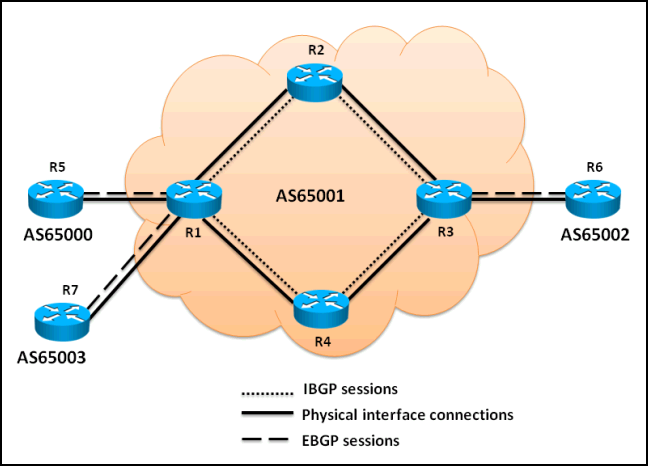
- A. The EBGP routing updates received by R1 from R5 will be propagated to the R2, R4, and R7 routers
- B. The EBGP routing updates received by R3 from R6 will be propagated to the R2 and R4 routers
- C. The EBGP routing updates received by R1 from R5 will be propagated to the R2 and R4 routers
- D. The IBGP routing updates received by R3 from R2 will be propagated to the R6 router
- E. The IBGP routing updates received by R2 from R1 will be propagated to the R3 router
- F. The IBGP routing updates received by R1 from R4 will be propagated to the R5, R7, and R2 routers
Answer : ABD
Question 2
R1 is designated as the PIM RP within the SP core. Which two configuration parameters must be used to enable and activate R1 as the BSR and RP for the core environment?
(Choose two.)
- A. ip pim send-rp-announce loopback0 scope 16
- B. ip pim bsr-candidate loopback0
- C. ip pim send-rp-discovery loopback0 scope 16
- D. ip pim rp-candidate loopback0
- E. ip pim send-RP-announce loopback0 scope 16 group-list 1
Answer : BD
Question 3
Which technology is categorized as multicast ASM and multicast SSM?
- A. IP telephony
- B. video conferencing
- C. IPTV
- D. live streaming
Answer : D
Question 4
Which multicast implementation is preferred for traffic that is required by a small number of receivers across a large distributed network?
- A. DVMRP
- B. PIM-DM
- C. PIM-SM
- D. IGMP
Answer : C
Question 5
Which command set implements BGP support for NSF/SSO on Cisco IOS XE between a
PE and a route reflector?
- A. On RR: router bgp 300 no synchronization bgp log-neighbor-changes bgp graceful-restart restart-time 120 bgp graceful-restart stalepath-time 360 bgp graceful-restart neighbor 10.20.20.2 remote-as 200 neighbor 10.20.20.2 update-source Loopback0 no auto-summary ! address-family vpnv4 neighbor 10.20.20.2 activate neighbor 10.20.20.2 send-community both neighbor 10.20.20.2 route-reflector-client exit-address-family On PE: router bgp 300 no synchronization bgp log-neighbor-changes bgp graceful-restart
- B. On RR: router bgp 300 no synchronization bgp log-neighbor-changes bgp graceful-restart restart-time 120 bgp graceful-restart stalepath-time 360 bgp graceful-restart neighbor 10.20.20.2 remote-as 200 neighbor 10.20.20.2 update-source Loopback0 no auto-summary ! address-family vpnv4 neighbor 10.20.20.2 activate neighbor 10.20.20.2 send-community both neighbor 10.20.20.2 route-reflector-client exit-address-family On PE: router bgp 300 no synchronization bgp log-neighbor-changes neighbor 10.20.02.1
- C. On RR: router bgp 300 no synchronization bgp log-neighbor-changes bgp graceful-restart restart-time 120 bgp graceful-restart stalepath-time 360 bgp graceful-restart neighbor 10.20.20.2 remote-as 200 neighbor 10.20.20.2 update-source Loopback0 no auto-summary ! address-family vpnv4 neighbor 10.20.20.2 activate neighbor 10.20.20.2 send-community both neighbor 10.20.20.2 route-reflector-client exit-address-family On PE: router bgp 300 no synchronization bgp log-neighbor-changes neighbor 10.20.20.1
- D. On RR: router bgp 300 no synchronization bgp log-neighbor-changes neighbor 10.20.20.2 remote-as 200 neighbor 10.20.20.2 update-source Loopback0 neighbor 10.20.20.2 ha-mode sso no auto-summary ! address-family vpnv4 neighbor 10.20.20.2 activate neighbor 10.20.20.2 send-community both neighbor 10.20.20.2 route-reflector-client exit-address-family On PE: router bgp 300 no synchronization bgp log-neighbor-changes neighbor 10.20.20.1 remote-as 300 neighbor 10.20.20.1 update-source Loopback0 neighbor
- E. On RR: router bgp 300 no synchronization bgp log-neighbor-changes neighbor 10.20.20.2 remote-as 200 neighbor 10.20.20.2 update-source Loopback0 no auto-summary ! address-family vpnv4 neighbor 10.20.20.2 activate neighbor 10.20.20.2 send-community both neighbor 10.20.20.2 route-reflector-client exit-address-family On PE: router bgp 300 no synchronization bgp log-neighbor-changes bgp graceful-restart restart-time 120 bgp graceful-restart stalepath-time 360 bgp graceful-restart neighbor 10.20.20.1
Answer : A
Question 6
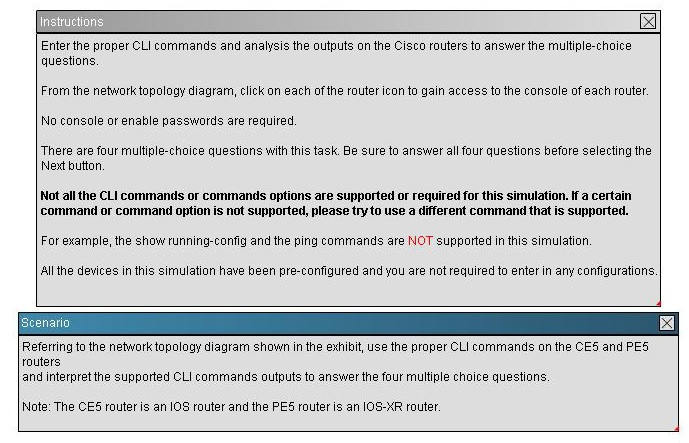
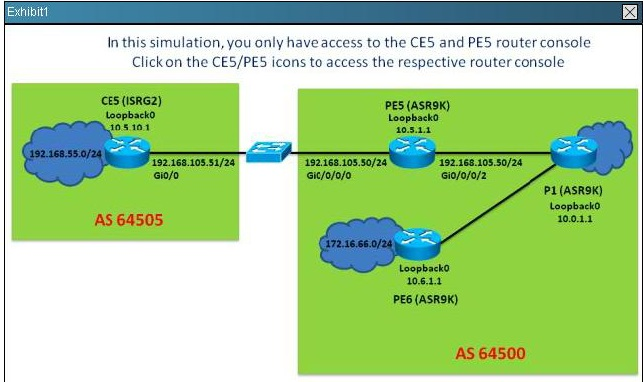
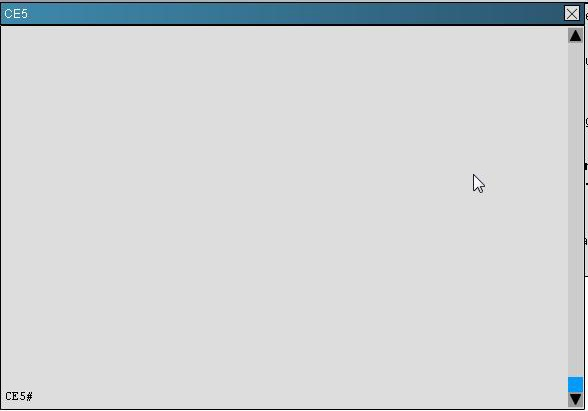
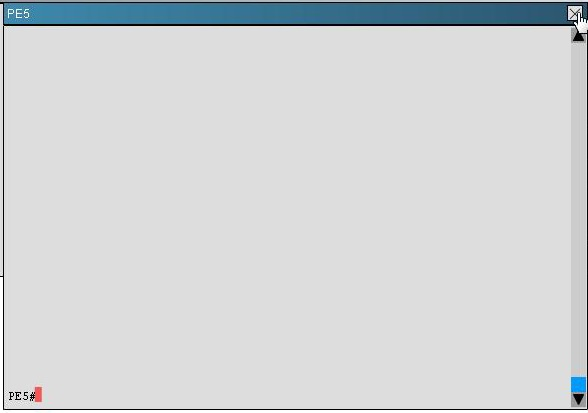
On the PE5 router, which statementis correct regarding the learned BGP prefixes?
- A. The 209.165.201.0/27 prefix is received from the 10.0.1.1 IBGP peer which is a route reflector
- B. The 172.16.66.0/24 prefix BGP next-hop points to the route reflector
- C. All prefixes learned on PE5 has the default local preference value
- D. The 209.165.202.128/27 prefix is originated by the 10.0.1.1 IBGP peer
Answer : C
Explanation: #show ip bgp -- check i tag for PE5
Question 7
A CRS router that runs Cisco IOS XR has dual routing processors installed. Which solution should be implemented to prevent OSPF adjacency flapping if the primary routing processor fails?
- A. NSR
- B. OSPF Fast Timers
- C. OSPF RE Sync
- D. router msdp
- E. NSF
Answer : A
Question 8
Which informationdoes the multicast supported router need to forward the multicast traffic over the source or shared tree?
- A. source address
- B. multicast address
- C. destination address
- D. mGRE headers
- E. MDT Data
Answer : C
Question 9
In Cisco IOS-XR, the maximum-prefix command, to control the number of prefixes that can be installed from a BGP neighbor, is configured under which configuration mode?
- A. RP/0/RSP0/CPU0:P2(config-bgp)#
- B. RP/0/RSP0/CPU0:P2(config-bgp-af)#
- C. RP/0/RSP0/CPU0:P2(config-bgp-nbr)#
- D. RP/0/RSP0/CPU0:P2(config-bgp-nbr-af)#
Answer : D
Explanation:
http://www.cisco.com/en/US/tech/tk365/technologies_configuration_example09186a00801
0a28a.shtml
Question 10
Which command set is used to implement an IPv6 PIM with the global scope embedded
RP address of 2001:DB8::1 on a Cisco IOS XE router?
- A. ipv6 unicast-routing ipv6 multicast-routing ipv6 pim rp-address 2001:DB8::1 bidir
- B. ipv6 multicast-routing ipv6 pim rp-address 2001:DB8::1
- C. ipv6 unicast-routing ipv6 multicast-routing ipv6 pim rp-address FF7E:0120:2001:DB8:1111::4321
- D. ipv6 unicast-routing ipv6 multicast-routing int Lo0 ipv6 mld join-group FF7E:0120:2001:DB8:1111::4321
- E. ipv6 unicast-routing ipv6 multicast-routing int Lo0 ipv6 mld join-group FF75:0120:2001:DB8:1111::4321
Answer : D
Question 11
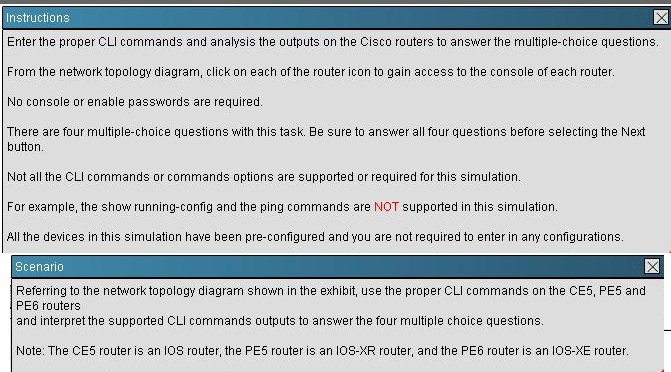
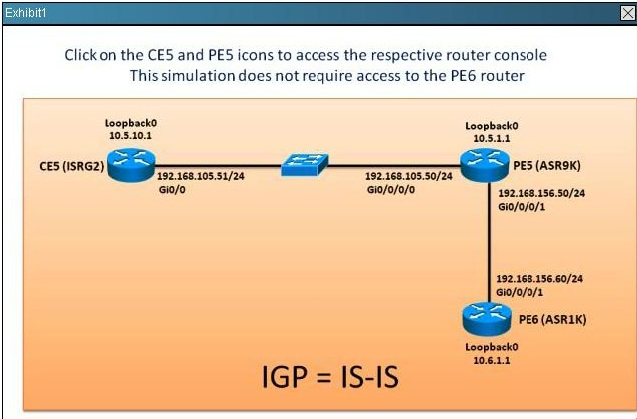
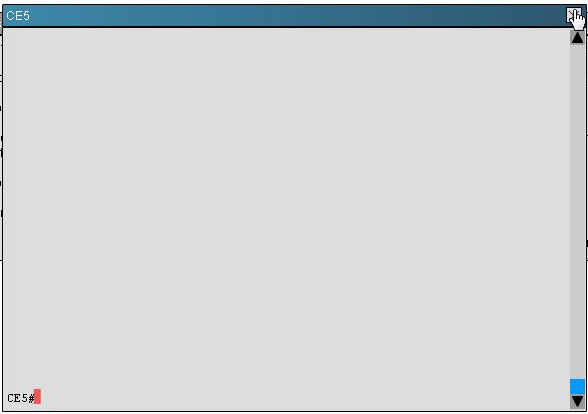
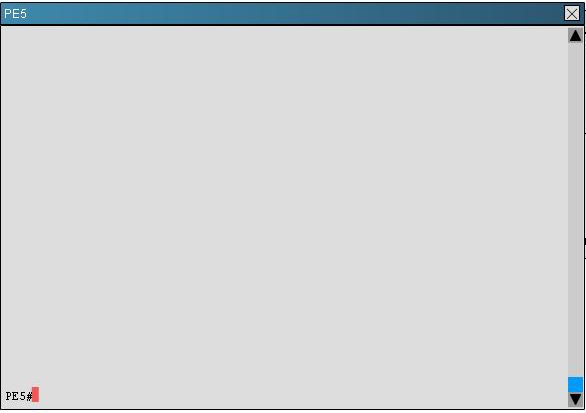
Which router is configured as the RPforthe 234.1.1.1 multicast group and which Is the multicast source that is currently sending traffic to the 234.1.1.1 multicast group? (Choose two.)
- A. CE5
- B. PE5
- C. PE6
- D. 10.5.10.1
- E. 10.5.1.1
- F. 192.168.156.60
Answer : C,E
Explanation: #show ip mroute234.1.1.1
#show ip route
Question 12
Which three statements regarding NAT64 operations are correct? (Choose three.)
- A. With stateful NAT64, many IPv6 address can be translated into one IPv4 address, thus IPv4 address conservation is achieved
- B. Stateful NAT64 requires the use of static translation slots so IPv6 hosts and initiate connections to IPv4 hosts.
- C. With stateless NAT64, the source and destination IPv4 addresses are embedded in the IPv6 addresses
- D. NAT64 works in conjunction with DNS64
- E. Both the stateful and stateless NAT64 methods will conserve IPv4 address usage
Answer : ACD
Explanation:
Stateful NAT64-Network Address and Protocol Translation from IPv6 Clients to IPv4
Servers -
Stateful NAT64 multiplexes many IPv6 devices into a single IPv4 address. It can be assumed that this technology will be used mainly where IPv6-only networks and clients (ie.
Mobile handsets, IPv6 only wireless, etc...) need access to the IPv4 internet and its services.
The big difference with stateful NAT64 is the elimination of the algorithmic binding between the IPv6 address and the IPv4 address. In exchange, state is created in the NAT64 device for every flow. Additionally, NAT64 only supports IPv6-initiated flows. Unlike stateless
NAT64, stateful NAT64 does `not' consume a single IPv4 address for each IPv6 device that wants to communicate to the IPv4 Internet. More practically this means that many IPv6- only users consume only single IPv4 address in similar manner as IPv4-to-IPv4 network address and port translation works. This works very well if the connectivity request is initiated from the IPv6 towards the IPv4 Internet. If an IPv4-only device wants to speak to an IPv6-only server for example, manual configuration of the translation slot will be required, making this mechanism less attractive to provide IPv6 services towards the IPv4
Internet. DNS64 is usually also necessary with a stateful NAT64, and works the same with both stateless and stateful NAT64
Stateless NAT64-Stateless translation between IPv4 and IPv6 RFC6145 (IP/ICMP
Translation Algorithm) replaces RFC2765 (Stateless IP/ICMP Translation Algorithm (SIIT)) and provides a stateless mechanism to translate a IPv4 header into an IPv6 header and vice versa. Due to the stateless character this mechanism is very effective and highly fail safe because more as a single-or multiple translators in parallel can be deployed and work all in parallel without a need to synchronize between the translation devices.
The key to the stateless translation is in the fact that the IPv4 address is directly embedded in the IPv6 address. A limitation of stateless NAT64 translation is that it directly translates only the IPv4 options that have direct IPv6 counterparts, and that it does not translate any
IPv6 extension headers beyond the fragmentation extension header; however, these limitations are not significant in practice.
With a stateless NAT64, a specific IPv6 address range will represent IPv4 systems within the IPv6 world. This range needs to be manually configured on the translation device.
Within the IPv4 world all the IPv6 systems have directly correlated IPv4 addresses that can be algorithmically mapped to a subset of the service provider's IPv4 addresses. By means of this direct mapping algorithm there is no need to keep state for any translation slot between IPv4 and IPv6. This mapping algorithm requires the IPv6 hosts be assigned specific IPv6 addresses, using manual configuration or DHCPv6.
Stateless NAT64 will work very successful as proven in some of the largest networks, however it suffe
Question 13
An engineer is enabling multicast routing across an entire core infrastructure. Which two commands enable multicast routing on Cisco IOS XE instances? (Choose two.)
- A. ip multicast-routing
- B. ip multicast-routing vrf global
- C. interface type slot/path_id ip pim sparse-mode
- D. interface type slot/path_id ip cgmp
- E. interface type slot/path_id ip pim dense-mode
- F. ip mroute-cache
Answer : AC
Question 14
An engineer is providing DNS for IPv6 over a currently working IPv4 domain. Which three changes are needed to offer DNS functionality for IPv6? (Choose three.)
- A. Define a new record that stores the 128-bit IPv6 address.
- B. Expand the existing IP address record to allow for 128 bits.
- C. Define the IPv6 equivalent of the in-addr.arpa.com domain of the IPv4 PTR.
- D. Modify the in-addr.arpa.com domain of the IPv4 PTR.
- E. Change the query messages.
- F. Transport IPv6 query messages by using UDP.
- G. Transport IPv6 query messages by using TCP.
Answer : ACE
Question 15
Which configuration would an engineer use to exchange IPv6 multicast routes via BGP with a neighbor that does not support thecorresponding Multicast SAFI onCisco IOS XE?
- A. router bgp 100 bgp router-id 209.165.201.10 no bgp default ipv4-unicast neighbor 2001:DB8::10 remote-as 201 neighbor 2001:DB8::10 update-source GigabitEthernet 0/10 address-family ipv6 multicast neighbor 2001:DB8::10 activate network 2001:DB8:CDCD:1::/64 exit-address-family
- B. router bgp 100 bgp router-id 209.165.201.10 no bgp default ipv4-unicast neighbor 2001:DB8::10 remote-as 201 neighbor 2001:DB8::10 update-source GigabitEthernet 0/10 address-family ipv6 neighbor 2001:DB8::10 translate-update ipv6 multicast unicast neighbor 2001:DB8::10 activate no synchronization exit address-family address-family ipv6 multicast neighbor 2001:DB8::10 activate network 2001:DB8:CDCD:1::/64 exit-address-family
- C. router bgp 100 bgp router-id 209.165.201.10 no bgp default ipv4-unicast neighbor 2001:DB8::10 remote-as 201 neighbor 2001:DB8::10 update-source GigabitEthernet 0/10 address-family ipv6 neighbor 2001:DB8::10 activate address-family ipv6 multicast neighbor 2001:DB8::10 activate network 2001:DB8:CDCD:1::/64 exit-address-family
- D. router bgp 100 bgp router-id 209.165.201.10 no bgp default ipv4-unicast neighbor 2001:DB8::10 remote-as 201 neighbor 2001:DB8::10 update-source GigabitEthernet 0/10 address-family ipv6 neighbor 2001:DB8::10 translate-update ipv6 multicast unicast no synchronization exit address-family address-family ipv6 multicast neighbor 2001:DB8::10 activate network 2001:DB8:CDCD:1::/64 exit-address-family
- E. router bgp 100 bgp router-id 209.165.201.10 no bgp default ipv4-unicast neighbor 2001:DB8::10 remote-as 201 neighbor 2001:DB8::10 update-source GigabitEthernet 0/10 address-family ipv6 neighbor 2001:DB8::10 send-label neighbor 2001:DB8::10 override-capability-neg neighbor 2001:DB8::10 activate no synchronization exit address-family address-family ipv6 multicast network 2001:DB8:CDCD:1::/64 exit-address-family
Answer : B